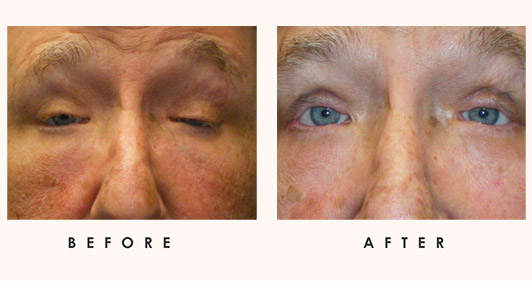Lacrimal Gland Tumors
Jump To
General
Lacrimal glands produce tears above and to the side of the eyes. If lacrimal gland cells change and grow abnormally, they can form a benign or malignant tumor. Benign tumors can grow but not spread; malignant tumors can spread to distant parts of the body.
At Idaho Eyelid and Facial Plastic Surgery, our practitioners examine patients for fullness of the upper lid, asymmetry of the superior sulcus, and abnormal lid contour. We also check whether the tumor is mobile, smooth, rubbery, or nodular. Proptosis (bulging eyeballs) is evidence of posterior growth. The majority of lacrimal gland masses are idiopathic inflammatory dacryoadenitis.
Imaging
CT scans help us differentiate inflammation from tumor evidence. Inflammation and lymphoid within the lacrimal gland can cause diffuse enlargement and elongated shape.
Pathology
Lacrimal gland tumors can range from epithelial lesions to lymphomas and sarcomas. The type of tumor depends on the type of cell that is abnormally proliferating.
Epithelial Tumors
Fifty percent of the masses involving the lacrimal gland are epithelial tumors; the other lesions are lympho-inflammatory lesions. Pleomorphic adenomas are the most common benign epithelial tumors. They are most common in patients 30-50 years old, with men affected more frequently. They present as palpable, painless, and slow-growing. CT scans can show if the growth is inflammatory or malignant (the lacrimal gland is oblong if inflammatory, globular if malignant). Treatment involves lateral orbitotomy with en bloc excision, including pseudocapsule. The remaining tumors are malignant mixed tumors and adenoid cystic carcinomas. The malignant mixed tumors are similar to benign mixed but with malignant change, and the adenoid cystic carcinoma is the most common (highly) malignant tumor of lac gland.
Non-Epithelial Lacrimal Gland Tumors
Non-epithelial lacrimal gland tumors develop in the lacrimal gland, and include lymphoma, some types of sarcomas, malignant melanomas, and other mixed tumors. These are all considered non-epithelial in nature.
Sarcoidosis
Sarcoidosis is a systemic disease of African or Scandinavian descent. It involves the lacrimal gland, the orbit and its soft tissue along with the optic nerve. It causes an inflammation of the uvea, which is the middle layer of the eye that includes the iris, ciliary body, and choroid.



